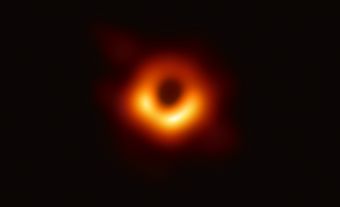Cosmology
How the world began is a question as old as the human race. It was not before the 20th century, however, that the evolution and large-scale structure of the universe emerged as a well-defined problem of interest to science.
Measurements of residual radioactivity in rocks beginning in the early 1900s proved that the material making up the Earth could not have existed in anything like its present form for more than 4.5 billion years. By 1930, astronomers (notably Edwin P. Hubble at Mount Wilson Observatory) had accumulated evidence for a beginning to the universe as a whole, in an explosive event ("big bang") roughly 10 billion years ago. The spectra of distant galaxies reveal a systematic shift of their light toward the red, indicating that they are speeding away from each other in a manner consistent with such an explosive origin.
Strong supportive evidence for the big bang came in 1965, when Arno Penzias and Robert W. Wilson at the Bell Telephone Laboratories in Princeton, New Jersey identified the origin of a high-frequency noise in their radio receivers as a background of microwave radiation uniformly filling space. This is generally held to be radiation from an early, very hot and dense phase of the big bang, which has cooled with the expansion to its present low temperature.
As early as 1941, Andrew MCKELLAR at the Dominion Astrophysical Observatory (Victoria, BC) had inferred the existence and temperature of the microwave background from the excitation of interstellar cyanogen molecules, but the cosmological implications were not then understood. In 1992, a University of British Columbia team (H. Gush, M. Halpern and E.H. Vishnow), using balloon-launched spectrometers, achieved unprecedented accuracy in measuring the temperature and spectral properties of the radiation.
The picture of cosmic evolution now generally accepted is already in clear focus only seconds from the moment of creation. At 2 seconds, the cosmic temperature was 10 billion degrees. Over the next 3 minutes, the universe expanded and cooled by a factor of 10. In this interval, conditions were optimal for the rapid synthesis of helium and other light elements by thermonuclear fusion. Computer simulations of the amounts produced (initiated at Princeton University in 1966 by the Canadian cosmologist P. James E. Peebles, and since refined and extended) can be compared with the abundances observed today. The agreement is excellent. This is the most compelling evidence we have that the big bang model gives a broadly correct account of cosmic evolution from the first few seconds onwards.
After a million years, the universe became transparent. Gravity began slowly to gather the material into stars, galaxies and clusters of galaxies, with the smallest aggregates forming first, according to the "bottom-up" scenario first outlined by Peebles. The process of clustering imprinted tiny "ripples" on the cosmic microwave background. These were first detected in 1992 by the NASA satellite instrument COBE (Cosmic Background Explorer). Fundamental contributions to the understanding of these later phases of cosmic evolution are due to J. Richard Bond and Nick Kaiser, both at the Canadian Institute for Theoretical Astrophysics, and to David S. Salopek (now at University of Alberta).
What happened before and during the first second? This question has fuelled much speculation. All we really know is that the simplest version of the big bang model here needs modification. Stephen Hawking (Cambridge, England), Don N. Page (U Alberta) and William G. Unruh (UBC) are among the cosmologists grappling with these issues. A fertile though speculative idea known as "inflation" was proposed in 1981 by the American physicist Alan H. Guth. It conjectures that the primeval cosmos underwent a phase transition during which it was gripped for a brief fraction of a second by a tensile force which enormously distended the material and built up its mass proportionately. If this happens to be near the truth, it raises the fantastic possibility that the material of the cosmos "created itself" out of virtually nothing!
Will the expansion continue forever? Or is the universe destined to recollapse, ending in a fiery big crunch? According to general relativity, that depends on whether the average density of matter - a parameter not now known with accuracy - is large enough to create the gravity needed to bring the expansion to a halt. (On the inflationary hypothesis, the universe may be poised on the knife edge between the 2 alternatives, which would make an observational decision very difficult.)
A promising approach to determining the density and distribution of cosmic material is through its gravitational effects in bending the light and deforming the images of distant galaxies. Robert C. Roeder and Charles C. Dyer (University of Toronto) were among the first to take seriously the possibility of measuring such "gravitational lensing" effects. The idea has been developed further by Anthony Tyson of the Bell Telephone Laboratories in New Jersey and has been honed into a sophisticated tool by Nick Kaiser (CITA). It is currently being implemented by Kaiser and his collaborators G.G. Fahlman (UBC), Gordon Squires and David Woods (both U of T), as well as teams in Great Britain, France and the US.
A major development of the last 2 decades has been the dawning recognition that between 90 and 99% of the matter that fills the universe is in some nonluminous, transparent form, detectable only through its gravitational effects. To understand the nature of this material is the foremost challenge facing cosmologists today.
Canadian observational work in cosmology has long held an honoured place internationally. The Canada-France-Hawaii Telescope (CHFT) on Mauna Kea has the best observing site in the world. The doyen of Canadian observers is Sidney VAN DEN BERGH, a noted authority on the cosmic distance scale and the classification of galaxies.
In 1994, a Canadian team which included Van den Bergh used the high-resolution camera of CFHT to resolve individual images of pulsating variable stars in a galaxy of the Virgo cluster 50 million light-years away. This gives a new estimate of the distance to Virgo (independently confirmed by the Hubble Space Telescope), and leads, on the simplest interpretation, to the inference that the expansion of the universe began about 8 billion years ago. However, astronomers have firm grounds for believing that the oldest stars in our galaxy have been shining steadily for about 15 billion years. Further measurements and vigorous attempts now being made to resolve or explain the discrepancy should lead to significant advances in our understanding in the next few years.
In the area of mathematical cosmology, University of Waterloo has a concentration of specialists, including C.B. Collins, J. Wainwright and P.S. Wesson.
Theoretical research in Canada was transformed in 1985 by the formation of the Canadian Institute for Theoretical Astrophysics, a national institute under the stewardship of Scott D. Tremaine, with headquarters in Toronto - and, simultaneously, the creation of the Cosmology Program (Director, W.G. Unruh) of the Canadian Institute for Advanced Research, with nodes at CITA, UBC and U of A.
Today, Canada ranks (with the United States and Great Britain) as one of the 3 world leaders in the field of cosmological research.
See also ASTRONOMY; MOLECULES IN INTERSTELLAR SPACE; and OBSERVATORY.

 Share on Facebook
Share on Facebook Share on X
Share on X Share by Email
Share by Email Share on Google Classroom
Share on Google Classroom


